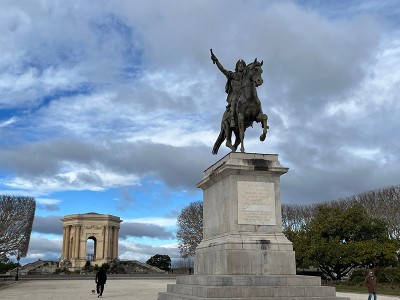December 26, 2025 07:33 pm (IST)
Pushkar: A magnet for tourists on a soul journey

Located to the northwest of Ajmer, the tranquil city of Pushkar is a magnet for tourists. Thousands of tourists from India and abroad flocking to Rajasthan visit Pushkar. Situated at a height of 510 metres, Pushkar is surrounded by hillocks on three sides. The ‘Nag Pahar’, literally meaning Snake Mountain forms a natural border between Ajmer and Pushkar. Along with an interesting mythological history, a legacy of timeless architectural heritage makes Pushkar a fascinating city. According to legends, Lord Brahma, believed to be the creator of the Universe dropped a lotus to the ground leading to the immediate creation of a lake. He then decided to name the place after the flower, and thus the name, Pushkar. The city of Pushkar is home to the only temple dedicated to Lord Brahma in the whole world. Hindus consider a journey to Pushkar to be the ultimate pilgrimage that must be undertaken to attain salvation. Camels, men in colourful turbans and a spiritual amalgam beyond religions make Pushkar one of the most soulful places to visit in India. Now besides the famous Pushkar Mela, a new addition is the two-day-long Shree Cement Sacred Pushkar festival that every December bring alive the town with music, melody and spirituality. Images by Avishek Mitra/IBNS

Located to the northwest of Ajmer, the tranquil city of Pushkar is a magnet for tourists. Thousands of tourists from India and abroad flocking to Rajasthan visit Pushkar. Situated at a height of 510 metres, Pushkar is surrounded by hillocks on three sides. The ‘Nag Pahar’, literally meaning Snake Mountain forms a natural border between Ajmer and Pushkar. Along with an interesting mythological history, a legacy of timeless architectural heritage makes Pushkar a fascinating city. According to legends, Lord Brahma, believed to be the creator of the Universe dropped a lotus to the ground leading to the immediate creation of a lake. He then decided to name the place after the flower, and thus the name, Pushkar. The city of Pushkar is home to the only temple dedicated to Lord Brahma in the whole world. Hindus consider a journey to Pushkar to be the ultimate pilgrimage that must be undertaken to attain salvation. Camels, men in colourful turbans and a spiritual amalgam beyond religions make Pushkar one of the most soulful places to visit in India. Now besides the famous Pushkar Mela, a new addition is the two-day-long Shree Cement Sacred Pushkar festival that every December bring alive the town with music, melody and spirituality. Images by Avishek Mitra/IBNS

Located to the northwest of Ajmer, the tranquil city of Pushkar is a magnet for tourists. Thousands of tourists from India and abroad flocking to Rajasthan visit Pushkar. Situated at a height of 510 metres, Pushkar is surrounded by hillocks on three sides. The ‘Nag Pahar’, literally meaning Snake Mountain forms a natural border between Ajmer and Pushkar. Along with an interesting mythological history, a legacy of timeless architectural heritage makes Pushkar a fascinating city. According to legends, Lord Brahma, believed to be the creator of the Universe dropped a lotus to the ground leading to the immediate creation of a lake. He then decided to name the place after the flower, and thus the name, Pushkar. The city of Pushkar is home to the only temple dedicated to Lord Brahma in the whole world. Hindus consider a journey to Pushkar to be the ultimate pilgrimage that must be undertaken to attain salvation. Camels, men in colourful turbans and a spiritual amalgam beyond religions make Pushkar one of the most soulful places to visit in India. Now besides the famous Pushkar Mela, a new addition is the two-day-long Shree Cement Sacred Pushkar festival that every December bring alive the town with music, melody and spirituality. Images by Avishek Mitra/IBNS

Located to the northwest of Ajmer, the tranquil city of Pushkar is a magnet for tourists. Thousands of tourists from India and abroad flocking to Rajasthan visit Pushkar. Situated at a height of 510 metres, Pushkar is surrounded by hillocks on three sides. The ‘Nag Pahar’, literally meaning Snake Mountain forms a natural border between Ajmer and Pushkar. Along with an interesting mythological history, a legacy of timeless architectural heritage makes Pushkar a fascinating city. According to legends, Lord Brahma, believed to be the creator of the Universe dropped a lotus to the ground leading to the immediate creation of a lake. He then decided to name the place after the flower, and thus the name, Pushkar. The city of Pushkar is home to the only temple dedicated to Lord Brahma in the whole world. Hindus consider a journey to Pushkar to be the ultimate pilgrimage that must be undertaken to attain salvation. Camels, men in colourful turbans and a spiritual amalgam beyond religions make Pushkar one of the most soulful places to visit in India. Now besides the famous Pushkar Mela, a new addition is the two-day-long Shree Cement Sacred Pushkar festival that every December bring alive the town with music, melody and spirituality. Images by Avishek Mitra/IBNS

Located to the northwest of Ajmer, the tranquil city of Pushkar is a magnet for tourists. Thousands of tourists from India and abroad flocking to Rajasthan visit Pushkar. Situated at a height of 510 metres, Pushkar is surrounded by hillocks on three sides. The ‘Nag Pahar’, literally meaning Snake Mountain forms a natural border between Ajmer and Pushkar. Along with an interesting mythological history, a legacy of timeless architectural heritage makes Pushkar a fascinating city. According to legends, Lord Brahma, believed to be the creator of the Universe dropped a lotus to the ground leading to the immediate creation of a lake. He then decided to name the place after the flower, and thus the name, Pushkar. The city of Pushkar is home to the only temple dedicated to Lord Brahma in the whole world. Hindus consider a journey to Pushkar to be the ultimate pilgrimage that must be undertaken to attain salvation. Camels, men in colourful turbans and a spiritual amalgam beyond religions make Pushkar one of the most soulful places to visit in India. Now besides the famous Pushkar Mela, a new addition is the two-day-long Shree Cement Sacred Pushkar festival that every December bring alive the town with music, melody and spirituality. Images by Avishek Mitra/IBNS
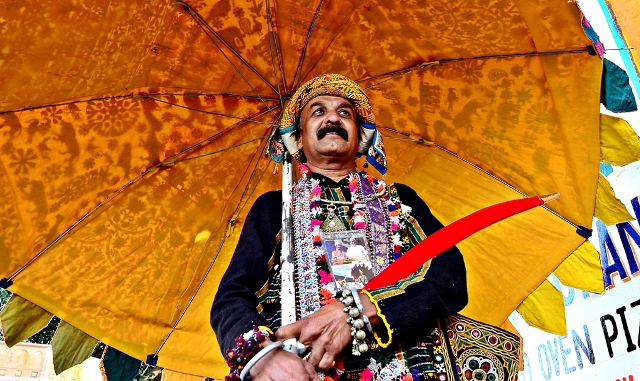
Located to the northwest of Ajmer, the tranquil city of Pushkar is a magnet for tourists. Thousands of tourists from India and abroad flocking to Rajasthan visit Pushkar. Situated at a height of 510 metres, Pushkar is surrounded by hillocks on three sides. The ‘Nag Pahar’, literally meaning Snake Mountain forms a natural border between Ajmer and Pushkar. Along with an interesting mythological history, a legacy of timeless architectural heritage makes Pushkar a fascinating city. According to legends, Lord Brahma, believed to be the creator of the Universe dropped a lotus to the ground leading to the immediate creation of a lake. He then decided to name the place after the flower, and thus the name, Pushkar. The city of Pushkar is home to the only temple dedicated to Lord Brahma in the whole world. Hindus consider a journey to Pushkar to be the ultimate pilgrimage that must be undertaken to attain salvation. Camels, men in colourful turbans and a spiritual amalgam beyond religions make Pushkar one of the most soulful places to visit in India. Now besides the famous Pushkar Mela, a new addition is the two-day-long Shree Cement Sacred Pushkar festival that every December bring alive the town with music, melody and spirituality. Images by Avishek Mitra/IBNS

Located to the northwest of Ajmer, the tranquil city of Pushkar is a magnet for tourists. Thousands of tourists from India and abroad flocking to Rajasthan visit Pushkar. Situated at a height of 510 metres, Pushkar is surrounded by hillocks on three sides. The ‘Nag Pahar’, literally meaning Snake Mountain forms a natural border between Ajmer and Pushkar. Along with an interesting mythological history, a legacy of timeless architectural heritage makes Pushkar a fascinating city. According to legends, Lord Brahma, believed to be the creator of the Universe dropped a lotus to the ground leading to the immediate creation of a lake. He then decided to name the place after the flower, and thus the name, Pushkar. The city of Pushkar is home to the only temple dedicated to Lord Brahma in the whole world. Hindus consider a journey to Pushkar to be the ultimate pilgrimage that must be undertaken to attain salvation. Camels, men in colourful turbans and a spiritual amalgam beyond religions make Pushkar one of the most soulful places to visit in India. Now besides the famous Pushkar Mela, a new addition is the two-day-long Shree Cement Sacred Pushkar festival that every December bring alive the town with music, melody and spirituality. Images by Avishek Mitra/IBNS

Located to the northwest of Ajmer, the tranquil city of Pushkar is a magnet for tourists. Thousands of tourists from India and abroad flocking to Rajasthan visit Pushkar. Situated at a height of 510 metres, Pushkar is surrounded by hillocks on three sides. The ‘Nag Pahar’, literally meaning Snake Mountain forms a natural border between Ajmer and Pushkar. Along with an interesting mythological history, a legacy of timeless architectural heritage makes Pushkar a fascinating city. According to legends, Lord Brahma, believed to be the creator of the Universe dropped a lotus to the ground leading to the immediate creation of a lake. He then decided to name the place after the flower, and thus the name, Pushkar. The city of Pushkar is home to the only temple dedicated to Lord Brahma in the whole world. Hindus consider a journey to Pushkar to be the ultimate pilgrimage that must be undertaken to attain salvation. Camels, men in colourful turbans and a spiritual amalgam beyond religions make Pushkar one of the most soulful places to visit in India. Now besides the famous Pushkar Mela, a new addition is the two-day-long Shree Cement Sacred Pushkar festival that every December bring alive the town with music, melody and spirituality. Images by Avishek Mitra/IBNS

Located to the northwest of Ajmer, the tranquil city of Pushkar is a magnet for tourists. Thousands of tourists from India and abroad flocking to Rajasthan visit Pushkar. Situated at a height of 510 metres, Pushkar is surrounded by hillocks on three sides. The ‘Nag Pahar’, literally meaning Snake Mountain forms a natural border between Ajmer and Pushkar. Along with an interesting mythological history, a legacy of timeless architectural heritage makes Pushkar a fascinating city. According to legends, Lord Brahma, believed to be the creator of the Universe dropped a lotus to the ground leading to the immediate creation of a lake. He then decided to name the place after the flower, and thus the name, Pushkar. The city of Pushkar is home to the only temple dedicated to Lord Brahma in the whole world. Hindus consider a journey to Pushkar to be the ultimate pilgrimage that must be undertaken to attain salvation. Camels, men in colourful turbans and a spiritual amalgam beyond religions make Pushkar one of the most soulful places to visit in India. Now besides the famous Pushkar Mela, a new addition is the two-day-long Shree Cement Sacred Pushkar festival that every December bring alive the town with music, melody and spirituality. Images by Avishek Mitra/IBNS
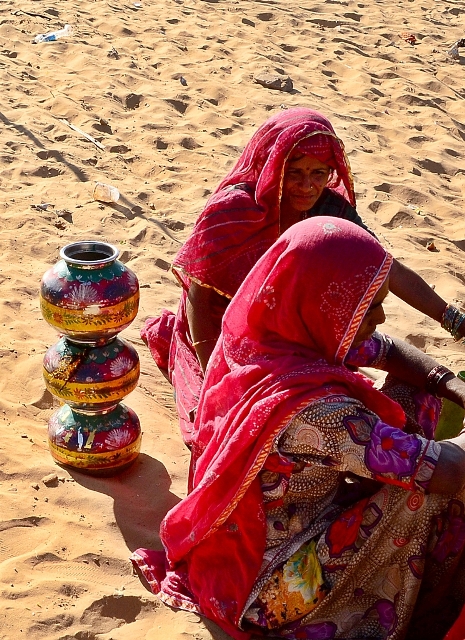
Located to the northwest of Ajmer, the tranquil city of Pushkar is a magnet for tourists. Thousands of tourists from India and abroad flocking to Rajasthan visit Pushkar. Situated at a height of 510 metres, Pushkar is surrounded by hillocks on three sides. The ‘Nag Pahar’, literally meaning Snake Mountain forms a natural border between Ajmer and Pushkar. Along with an interesting mythological history, a legacy of timeless architectural heritage makes Pushkar a fascinating city. According to legends, Lord Brahma, believed to be the creator of the Universe dropped a lotus to the ground leading to the immediate creation of a lake. He then decided to name the place after the flower, and thus the name, Pushkar. The city of Pushkar is home to the only temple dedicated to Lord Brahma in the whole world. Hindus consider a journey to Pushkar to be the ultimate pilgrimage that must be undertaken to attain salvation. Camels, men in colourful turbans and a spiritual amalgam beyond religions make Pushkar one of the most soulful places to visit in India. Now besides the famous Pushkar Mela, a new addition is the two-day-long Shree Cement Sacred Pushkar festival that every December bring alive the town with music, melody and spirituality. Images by Avishek Mitra/IBNS
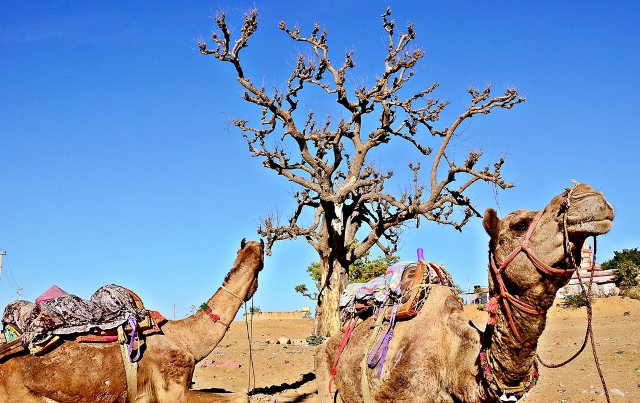
Located to the northwest of Ajmer, the tranquil city of Pushkar is a magnet for tourists. Thousands of tourists from India and abroad flocking to Rajasthan visit Pushkar. Situated at a height of 510 metres, Pushkar is surrounded by hillocks on three sides. The ‘Nag Pahar’, literally meaning Snake Mountain forms a natural border between Ajmer and Pushkar. Along with an interesting mythological history, a legacy of timeless architectural heritage makes Pushkar a fascinating city. According to legends, Lord Brahma, believed to be the creator of the Universe dropped a lotus to the ground leading to the immediate creation of a lake. He then decided to name the place after the flower, and thus the name, Pushkar. The city of Pushkar is home to the only temple dedicated to Lord Brahma in the whole world. Hindus consider a journey to Pushkar to be the ultimate pilgrimage that must be undertaken to attain salvation. Camels, men in colourful turbans and a spiritual amalgam beyond religions make Pushkar one of the most soulful places to visit in India. Now besides the famous Pushkar Mela, a new addition is the two-day-long Shree Cement Sacred Pushkar festival that every December bring alive the town with music, melody and spirituality. Images by Avishek Mitra/IBNS
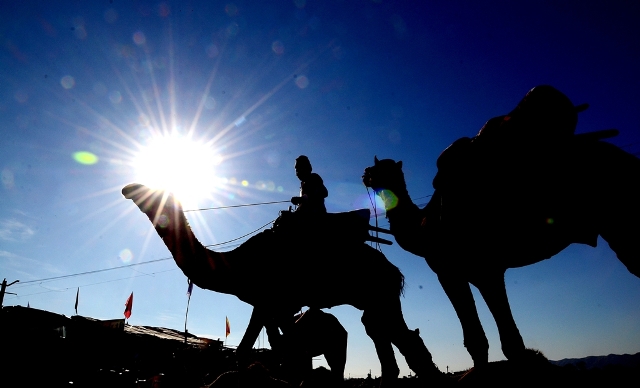
Located to the northwest of Ajmer, the tranquil city of Pushkar is a magnet for tourists. Thousands of tourists from India and abroad flocking to Rajasthan visit Pushkar. Situated at a height of 510 metres, Pushkar is surrounded by hillocks on three sides. The ‘Nag Pahar’, literally meaning Snake Mountain forms a natural border between Ajmer and Pushkar. Along with an interesting mythological history, a legacy of timeless architectural heritage makes Pushkar a fascinating city. According to legends, Lord Brahma, believed to be the creator of the Universe dropped a lotus to the ground leading to the immediate creation of a lake. He then decided to name the place after the flower, and thus the name, Pushkar. The city of Pushkar is home to the only temple dedicated to Lord Brahma in the whole world. Hindus consider a journey to Pushkar to be the ultimate pilgrimage that must be undertaken to attain salvation. Camels, men in colourful turbans and a spiritual amalgam beyond religions make Pushkar one of the most soulful places to visit in India. Now besides the famous Pushkar Mela, a new addition is the two-day-long Shree Cement Sacred Pushkar festival that every December bring alive the town with music, melody and spirituality. Images by Avishek Mitra/IBNS

Located to the northwest of Ajmer, the tranquil city of Pushkar is a magnet for tourists. Thousands of tourists from India and abroad flocking to Rajasthan visit Pushkar. Situated at a height of 510 metres, Pushkar is surrounded by hillocks on three sides. The ‘Nag Pahar’, literally meaning Snake Mountain forms a natural border between Ajmer and Pushkar. Along with an interesting mythological history, a legacy of timeless architectural heritage makes Pushkar a fascinating city. According to legends, Lord Brahma, believed to be the creator of the Universe dropped a lotus to the ground leading to the immediate creation of a lake. He then decided to name the place after the flower, and thus the name, Pushkar. The city of Pushkar is home to the only temple dedicated to Lord Brahma in the whole world. Hindus consider a journey to Pushkar to be the ultimate pilgrimage that must be undertaken to attain salvation. Camels, men in colourful turbans and a spiritual amalgam beyond religions make Pushkar one of the most soulful places to visit in India. Now besides the famous Pushkar Mela, a new addition is the two-day-long Shree Cement Sacred Pushkar festival that every December bring alive the town with music, melody and spirituality. Images by Avishek Mitra/IBNS

Located to the northwest of Ajmer, the tranquil city of Pushkar is a magnet for tourists. Thousands of tourists from India and abroad flocking to Rajasthan visit Pushkar. Situated at a height of 510 metres, Pushkar is surrounded by hillocks on three sides. The ‘Nag Pahar’, literally meaning Snake Mountain forms a natural border between Ajmer and Pushkar. Along with an interesting mythological history, a legacy of timeless architectural heritage makes Pushkar a fascinating city. According to legends, Lord Brahma, believed to be the creator of the Universe dropped a lotus to the ground leading to the immediate creation of a lake. He then decided to name the place after the flower, and thus the name, Pushkar. The city of Pushkar is home to the only temple dedicated to Lord Brahma in the whole world. Hindus consider a journey to Pushkar to be the ultimate pilgrimage that must be undertaken to attain salvation. Camels, men in colourful turbans and a spiritual amalgam beyond religions make Pushkar one of the most soulful places to visit in India. Now besides the famous Pushkar Mela, a new addition is the two-day-long Shree Cement Sacred Pushkar festival that every December bring alive the town with music, melody and spirituality. Images by Avishek Mitra/IBNS
Support Our Journalism
We cannot do without you.. your contribution supports unbiased journalism
IBNS is not driven by any ism- not wokeism, not racism, not skewed secularism, not hyper right-wing or left liberal ideals, nor by any hardline religious beliefs or hyper nationalism. We want to serve you good old objective news, as they are. We do not judge or preach. We let people decide for themselves. We only try to present factual and well-sourced news.
Support objective journalism for a small contribution.
Latest Headlines
Montpellier: The southern France city basking in Mediterranean light
Mon, Apr 01 2024
Water Jump event in Athens
Mon, Jul 26 2021
Tourists taking a shikara ride in Srinagar's Dal Lake
Fri, Jul 02 2021
A glimpse of the front view of famous Hazratbal Shrine in Srinagar
Fri, Jun 25 2021
A tourist enjoying water skiing in Kashmir's Dal Lake
Thu, Jun 24 2021
Pushkar: A magnet for tourists on a soul journey
Fri, Dec 29 2017
The aura of Ganga Aarti at Varanasi
Mon, May 30 2016
Kerala invitees tourists to experience ‘God’s Own Country’
Thu, Jan 21 2016
Maldives: Turquoise memories
Wed, Sep 30 2015





